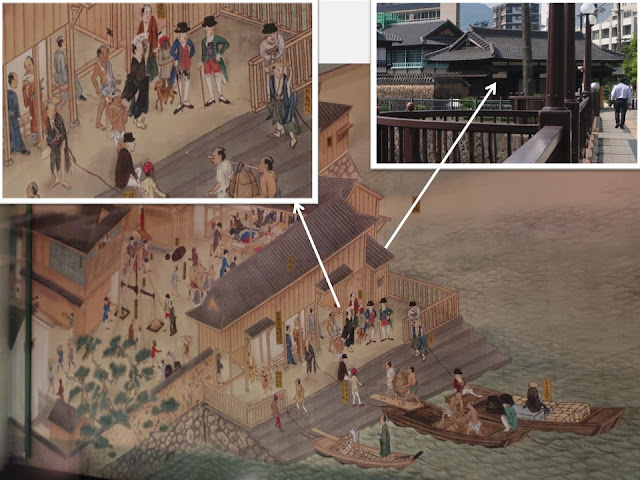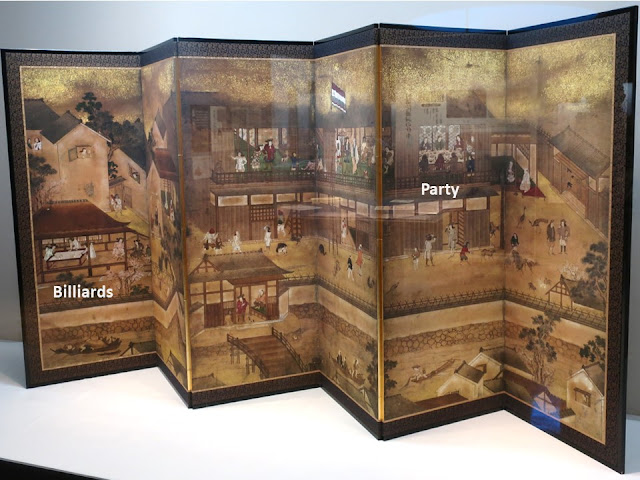During
the Edo
period (1603~1868), the shogunate (ruler) kept the
national isolation policy. Japan had diplomatic relations with China, Korea and
Netherland only. Its window was Nagasaki. The museum focuses on the
international exchange and lives of locals.
Link of Part 1 (Exchange with Korea and China/Lives in Nagasaki)、パート1(←リンク)は、朝鮮・中国との交流と長崎の暮しです。
Exchange with Netherlands、オランダとの交流
Nagasaki was a sole place where Japanese people took European culture, economics and politics. Dejima small artificial island was a Dutch settlement; it is introduced as the island connected to the world.
江戸時代のヨーロッパの文化、経済、政治が伝わる唯一の場所でした。「世界とつながる島」として出島が紹介されています。
Inspiring imports came from the gate of Dejima, which is on land now because of landfill.
出島の水門は今は埋め立てられて陸地ですが、ここから新しい物が続々と入ってきました。興奮したでしょうね。
Dejima gate passes were delivered to the authorized people.
出島へのパスポート、出島門鑑です。これがあれば、日本人も出島へ入れます。
Interpreters played two roles; one was interpreting and another was trading. It is written, they had a priority to buy imports and they were licensed to sell medicine and books. The rule enhanced their motivation and performance, I think. As I wrote in part 1, even prostitutes and coolies were practically importers. It’s so flexible.
オランダ通詞の仕事として、通訳と商売がありました。「商売」では、「輸入品を優先的に買い取る権利を持ち、薬種や書籍の販売も可能でした」とあります。ゆるいコンプラで、やる気と効率を上げていますね。パート1で記載しましたが、遊女と人夫も輸入ルートになっていますから。すごい。
“Folding screen of Dutch Factory” (replica, around the 18th century) shows us the life in Dejima. They enjoy billiards and a party. There are birds and animals on the street, but I cannot find Japanese ladies.
Reference(参照):Site of former Dutch Factory on Dejima in Nagasaki、出島和蘭商館跡
蘭館屏風(複製、18世紀頃)。出島といえばこのイメージですね。ビリヤード(左中)、宴会(二階右)ありです。この絵には遊女はいないようですが、道路に動物がたくさんいます。
The journey to Edo (old name of Tokyo) was great fun for Dutch envoy and clerks, because they could go out of Dejima. They went to Edo, met the shogun and reported the world situation. They went every year at first, but every four years since 1790. The mission consisted of around 60 members including Japanese guards. They had a meeting with local scholars in Edo and on the way; it is written “a golden opportunity to interexchange between both sides.”
Around fifteen Dutch stationed at Dejima. Some of them liked Japan. And a few of them got married with Japanese and had child.
出島を出られる江戸参府は、商館員の一番の楽しみですね。当初は毎年だったのですが、1790年からは4年に一度になってしまいました。日本人を含めて一行は約60人で、各所では蘭学者が訪れ、絶好の交流の機会になりました。
常駐のオランダ人は15人ぐらいで、日本好きになった人もいました。日本人の妻も持ったシーボルトは・・・これは、女好きかもしれない。
Many ambitious people came to Nagasaki to study. They went there to seek for a trigger to change Japan and them, I think. Nagasaki was attractive.
長崎には、日本中からいろいろな人が来ました。長崎なら何かある。出口やきっかけを求めて来たのだと思います。
The forerunner of modernization, Nagasaki、近代化の魁・長崎
The people who studied in Nagasaki changed Japan. The photo above is Nagasaki in 1866 which is the end of the Edo period.
展示のつなぎかたが上手いですね。1866年の長崎、展示に入り込めます。
Sakamoto Ryoma (1836-1867) was a hero of the end of the Edo period. He is very popular even until now because of his will and lifestyle. We can take photo with him.
でも、なんだかんだで坂本龍馬。長崎の写真師・上野彦馬の展示場所に、龍馬ポーズで写真を撮れるコーナーがあります。
Japanese, are familiar with them because they are hero and heroin in a drama themed the end of the Edo period. After the Edo period (1603~1868), Nagasaki prospered by the port to Shanghai, steel manufacturing and shipbuilding. Modern era is exhibited which is out of scope of my blog.
大浦慶さんの写真もあり、大河ドラマの世界です。余貴美子さんが演じていましたが、あか抜けた人ですね。製鉄、造船、上海航路。近代の長崎へと展示は続きます。
The photo above was taken in 1875; Kameyama Shachu was a political and business group led by Sakamoto.
長崎奉行所が師範学校になった1875年の写真です。中島川を挟んだ山側には、龍馬が亀山社中を構えた建物も写っているそうなのですが、よく分かりません。(亀山社中記念館で説明していただいたのに、残念)
Ordinary people in 1870; they probably dressed up as much as they could.
庶民の集合写真(1870)。普段着ですが、目一杯のおめかしですね。
The Japanese Government of Nagasaki Exhibition Room、長崎奉行所展示室
The museum is at the site of the shogunate branch-office. The office was rebuilt.
博物館の敷地は、長崎奉行所(立山役所)でした。奉行所が復元されています。
Who were the Nagasaki Magistrates? (The head of the Japanese Government of Nagasaki) His income was 4.5 million dollars in current value. He usual was promoted to a financial minister and so on.
長崎奉行の本給は、2億8千万相当の役高役料と3億5千万の在勤料(1865年)。相当な金額です。4~5年の在任期間でした。その後の役職は、勘定奉行が一番多かったです。
Mr. Toyama’s diary, who was the magistrates for four years since 1812, is shown. He had a fun time to see Kunchi Festival and so on. However, he was busy because foreign countries approached to Japan at that time, Nagasaki was a window for them.
1812年から4年務めた遠山左衛門尉景晋(かげみち、「遠山の金さん」のモデル)の日記が紹介されています。前任者とのくんち見物などもありましたが、対外交渉が活発化していた時期であり、忙しそうです。
The building is well rebuilt. きちんとお金をかけた良い復元建物です。
Dinner at Hamakatsu in Nagasaki、夕食
“Shippoku” is a specialty of Nagasaki, which consists of Japanese, Chinese and European cuisines. It shows the characteristic of the traditional international city. We eat Ohire (tail fin, ①) at first which shows us what kind of fish is cooked for the dinner. Then, we make a toast ②, eat sashimi (raw fish, ③) and so on. (The number on the photo is the order to be served.) My favorite was “Hatoshi”④; minced shrimps are wrapped by a slice of white bread and are deep-fried. It’s western taste.
長崎といえば和洋中をミックスした卓袱料理ですが、テーブルに並べるのは多すぎるので唐寺・崇福寺の門前の浜勝さんで、一人用の卓袱をいただきました。数字の順で食べます。まず、この日に出される魚の尾鰭を使った汁物、その名も「尾ひれ」でいただいてから、乾杯するのが作法です。④「ハトシ」が特に美味しかったです。エビのすり身を食パン包んで揚げた料理です。洋風ですね。
Visited in May, 2022
Official website: http://www.nmhc.jp/global/english/index.html
http://www.nmhc.jp/ (in Japanese), accessed in November, 2022
Previous post (part1
of this museum): Nagasaki Museum of History and Culture (1/2)、長崎歴史文化博物館 part1
Next post (museum in the same city): Site of former Dutch Factory on Dejima、出島和蘭商館跡

















Comments
Post a Comment